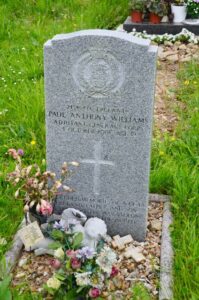Several local men from West Wales have died on active service in the years following the end of the Second World War in 1945. Some have fallen during later conflicts, such as Korea, The Falklands, Iraq and Afghanistan, while some died accidentally while serving in the forces. Some of these men are commemorated on their local war memorials, but many are not. As a result I have created this page to commemorate all of the known Post-WW2 casualties from west Wales. Sadly the toll of the fallen is still being added to today due to the continued instability, especially in the Middle East. If there is anyone missing from this roll, please let me know, as I can easily update or amend it. Also any photographs of any of these men would be most welcome.
Ireland/ Northern Ireland, 1916-Present
Following the formation of the Irish Republican Army on 25 November 1913, the Irish launched a campaign to drive the British out of Ireland, after over 300 years of British rule. The first major attacks were during the Easter Rising of April 1916, and in the post WW1 murders of several former British officers who were working undercover in Dublin. After much loss of life, a truce was agreed on 11 July 1921, and the British moved out of Southern Ireland, and the Irish Civil War began. The British regained control of Northern Ireland, but the country even today is split between the various factions, mostly Protestant and Catholic, and a high casualty rate has been suffered by all camps ever since in a campaign which began in 1969 and has only recently slowed down. At least four men from West Wales died or were murdered during IRA’s campaign in Dublin, three of whom were veterans of the Great War.
Parcell Rees Bowen, MC, DFC and Bar, Captain, Welsh Regiment. Parcell Rees Bowen was the fourth son of Josiah and Mary Bowen, of Pantyglien, Abergwili. Parcell was a student at St. David’s College, Lampeter when he enlisted at the outbreak of War, becoming a Private in the Army Service Corps. He spent the Winter of 1914/15 in France, but in February, 1915 was sent home with badly frostbitten feet. In July that year, he was commissioned as a Second Lieutenant into the 5th Welsh, and he embarked with the Battalion for Gallipoli, where the Battalion formed part of 159 Brigade, 53rd (Welsh) Division. The Division fought at Gallipoli until the evacuation in December, suffering badly from casualties, forcing the 5th Welsh to merge with the 4th Welsh for a short period. After the evacuation, Parcell fought in the Palestinian Campaign, where he then transferred into the Machine Gun Corps, and it was with them that he was awarded his first decoration, the Military Cross. Parcell then transferred into the Royal Air Force on 10 January 1918, becoming an Observer. He gained his second decoration during the air war in Egypt, the Distinguished Service Order. After the Armistice on 11 November 1918, Parcell served in Salonika and Mesopotamia, before being placed on the unemployed list. Again though, Parcell wanted more adventure, and so he volunteered for further service with the R.A.F. in their private war in North Russia, fighting for the White Russians. On 17 July 1919 Parcell arrived at Archangel, where he met his old compatriot from Carmarthen, Ira ‘Taffy’ Jones.
In Ira Jones’s book, ‘An Airfighter’s Scrapbook’, Ira writes glowing reports of Parcell, being glad to see another Welsh Warrior in his Squadron. A long passage from the book tells of an incident that earned Parcell a Bar to his Distinguished Flying Cross. In short, Parcell and his Pilot were carrying out a bombing mission when they came across a superior force of Russian Aeroplanes. Being the men they were, they agreed to attack the Russians, who dispersed in chaos when these two madmen plunged into their midst. The Russians took flight, but one fired a burst of rounds at the British pair, and Parcell and his Pilot were hit. The Pilot fainted at the controls of the aeroplane, and Parcell only had one good arm, but he leaned over his colleague and piloted the aeroplane back nearly 100 miles to base. Parcell was sent home wounded, and again placed on the Unemployed List, so volunteered for a Commission into the Lithuanian Army, with whom he served until July 1920 when he accepted a Government Post. This post was Top Secret, and involved him going undercover in Dublin, at the time when the troubles were at a peak. Due to the secrecy of the work being carried out in Ireland, nothing much is known about the operations Parcell was engaged in. What is known is that Parcell had been lodging with a fellow Officer at 28, Upper Fitzwilliam Street, Dublin, and the two had spent the afternoon of 27 October 1920 watching a football match at Donnybrook. After the match, Parcell could not be found, until his lifeless body was discovered, lying face down, at Merrion Street. He had been shot in the back by an IRA assassin, the bullet hitting his spine. Parcell’s body was brought back to Carmarthen, where he was buried with full military honours in Abergwili Churchyard. Within a month, on ‘Bloody Sunday’, 21 November 1920, fourteen British Agents were murdered in Dublin by the I.R.A., led by Michael Collins. The British Army reprised the killings by storming into a Gaelic Football match at Croke Park in Dublin, and fired into the crowd to avenge their murdered colleagues, inflicting many casualties, with fourteen men and children dead. Later that night, three IRA prisoners suspiciously died in captivity in Dublin Castle, and the situation swiftly escalated. The Irish Public quickly turned against the Crown, and Peace negotiations ensued, resulting in a truce being declared on 11 July 1921. (Note: the photographs and details about Parcell used on this website have been copied without permission for use on another site. This is their original source).
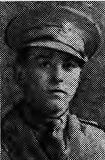
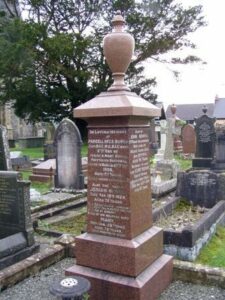
Joseph Hoare, Gunner, 1410699, Royal Garrison Artillery. Joseph was born in Market Street, Laugharne in 1899, the son of James and Francis Hoare. His father was a Policeman, and by 1911 the family had moved to Bonville House, Llansteffan. Joseph had enlisted in August 1914, at the grand age of 14 years old, and was posted to the Royal Garrison Artillery barracks at Plymouth as a Bugler. He later served in France and in East Africa during the war, returning home on leave in January 1919, before returning to Africa. He was later posted to Ireland during the height of the troubles, attached to the 19th Battery, 5th Brigade, Royal Garrison Artillery. Joseph died after being accidentally shot while on duty in Ireland on 10 June 1921, aged just 21. The Welshman newspaper reported that he had died of self-inflicted injuries, but another report in The Independent stated that he was actually trying to save a comrade who was trying to kill himself and the gun accidentally went off, killing him. Joseph is buried in Llansteffan Churchyard and the base of his CWGC headstone states that ‘He died to save a comrade’, so the Independent article was more likely correct.
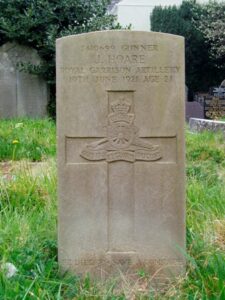
William Jones, Private, King’s Shropshire Light Infantry. William resided at Cwmcarn, Talog. He served with the 2nd Battalion, King’s Shropshire Light Infantry, which had served during the war attached to 80 Brigade, 27th Division. After the Armistice, the battalion was sent to Fermoy, in Southern Ireland. On Sunday 7 September 1919, William was one of a group of soldiers who were heading to attend a Church Service, when several cars pulled up, and the soldiers were fired upon by Sinn Fein activists. William was killed by the gunfire, which struck him in the chest. A resulting court case refused to treat the incident as murder, which prompted a riot by other members of his battalion, who went on the rampage in Fermoy, causing damage to around sixty shops. William was buried with full military honours at Blaenycoed Congregational Chapelyard, Cynwyl Elfed. Presently he is commemorated on the Brookwood (United Kingdom 1914-1918) Memorial, England. His brother Evan had been killed during the Great War.

Wynford Llewellyn, Private, 4954, Pembroke Yeomanry. Wynford was born in 1898, the son of Thomas and Sarah Llewellyn, of Church Lakes, Llanstadwell. He enlisted at Haverfordwest into the Pembroke Yeomanry. The regiment formed in Tenby at the outbreak of war, joining the 1st Mounted Division. In September 1915 the front line units of the division moved to Egypt, joining the Mediterranean Expeditionary Force. The second line unit of the Pembroke Yeomanry moved to Ireland, as part of the force sent to quell the Easter Uprising. Towards the end of the Easter Risings, on 29 April 1916 Wynford was stationed near Grangegorman Hospital and had gone out with some students from the hospital to bring in some wounded civilians. He returned inside afterwards and was given a cup of tea by a nurse, before going on guard duty. Half an hour after he went back out the nurse who gave him the tea heard news that someone had been shot. He was carried into the hospital by the same students he had earlier helped and died in the arms of the nurse. Wynford was just 17 years old when he was murdered and is buried at Grangegorman Military Cemetery, in the Republic of Ireland. (Another Welsh Yeoman, Private William Edgar Moy James (2442), of the Glamorgan Yeomanry, had been murdered by the IRA just five days earlier. He was the son of Edgar Griffith James and Annie James, of Caerau, Maesteg and is buried in Glasnevin (Or Prospect) Cemetery, Republic of Ireland.)
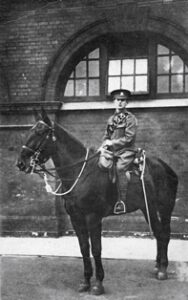
David Paul Thomas, Corporal, G8211611, Royal Air Force. David was born at Carmarthen on 16 April 1964. He served at RAF Aldergrove. David was killed in Northern Ireland on 29 June 1996, aged 32, and is commemorated at Mintlyn Crematorium, King’s Lynn, Norfolk.
John Tecwyn Herbert Williams, Private, 24143355, Royal Regiment of Wales. John was born in Carmarthen on 13 June 1950. He served with the Royal Regiment of Wales. John was killed by an IRA sniper while his patrol was engaged in a firefight in Belfast on 14 July 1972. His body was brought home to be buried in Brondeifi Unitarian Churchyard, Lampeter.
Michael James Winkler, Sergeant, 24310380, Royal Corps of Signals. Michael was born in Pembrokeshire on 17 March 1957, the son of Lothar Hans Winkler and Elizabeth Winkler (nee James). He was serving with the Royal Corps of Signals in Northern Ireland during the height of the troubles. On 15 June 1988, Michael, along with a group of other servicemen, were off duty, and had just completed a charity run for local charities in Northern Ireland. Michael, along with five other servicemen, boarded their minibus, which had been parked in the Market Square, Lisburn, County Antrim, when it exploded, killing all six of the men. The minibus had been targeted by the IRA, who had placed a bomb in it. The action of the IRA was condemned, rightly, as the men had given up some rare time off to raise money for local charities, and were all off duty. Michael was 31 years old. The other soldiers who died in the explosion were; Corporal Ian Metcalf, The Green Howards, aged 36; Lance Corporal Graham P. Lambie, Royal Corps of Signals, aged 22; Signalman Mark Clavey, Royal Corps of Signals, aged 24; Corporal William J. Paterson, Royal Corps of Signals, aged 22, and Lance Corporal Derek W. Green, Royal Army Ordnance Corps, aged 20. Michael’s body was brought home, and he was buried at Llannon Cemetery, near Tumble. (Other sources state St. Non’s Churchyard at Llanon, Ceredigion).
Palestine Partitioning, 1947-48
After the end of World War Two, and after the almost annihilation of the Jewish people in occupied Europe, the survivors wanted to build a new state in their historical homeland in Palestine. The British had governed Palestine since its liberation from Ottoman rule in 1917, and attempted to manage the flow of Jews into Palestine. An UNSCOP report on the matter recommended segregation of Palestine, thus creating a new Jewish state which would be known as Israel. We know today how divisive this plan has been, but in 1948 the soldiers of the UNSCOP force despatched to assist with the partitioning of Palestine didn’t realise how hostile the situation would become. This is not the place to go into detail about the resulting Palestinian War of 1948, but there is plenty of material available online.
Gwynne Keith Jackson, Trooper, 19066756, Royal Armoured Corps. Keith was born on 11 July 1928, the son of Albert Frederick and Elsie Clara Jackson, of Llangadog. He was too young to have served during the war, but enlisted into the 4th/7th Royal Dragoon Guards, which was an armoured reconnaissance unit. The 4th/7th Dragoons had served at Dunkirk in 1940, then in North Africa and Italy. It was then brought back to Britain, and took part in the Normandy Landings in June 1944. The regiment ended the war in Bremerhaven, and a year later was deployed to Palestine for a tour of duty lasting from 1946-1948. Gwyn served in Palestine, but became ill and died after a long spell in hospital in Jerusalem on 18 September 1947, aged 19. He is buried at Ramleh War Cemetery, Israel. His brother Norman was killed during World War Two.
Philip J. Russant, Trooper, 19192872, Royal Armoured Corps. Philip was born at Goodwick on 20 May 1929, the son of Martha Ann Russant (the sister of William Phillip Russant). He was too young to serve during WW2, but enlisted after the war into the 17th/21st Lancers, which was attached to the Royal Armoured Corps. In 1946 the regiment was posted to Greece on internal security duties. In 1947 it deployed to the Suez Canal Zone and re-equipped as an armoured car regiment, and then moved to Palestine in 1948 on peace-keeping duties. Philip was just 18 years old when he was killed in Palestine on 13 March 1948. He is buried at Haifa War Cemetery, Israel. Philip is not commemorated on any memorial locally. Many thanks to Chris Lanham for supplying the details about Philip.
Noel Benjamin Wilkins, Gunner, 14452128, Royal Artillery. Noel was born at Llanelli on 15 December 1926, and lived at 553, Glas Fryn, Dafen. He served with the Royal Artillery in Palestine. He was killed on 29 February 1948 while travelling on the Cairo-Haifa train that struck a mine which had been laid by Jewish activists. He was 21 years old and is buried in Ramleh War Cemetery, Israel.
Korean War, 1950-1953
Following the surrender of the Japan in September 1945, the Americans divided the Korean peninsula along the 38th parallel, with U.S. forces occupying the southern half and Soviet forces occupying the northern half. The Korean War was brought about by the spread of Communism through China into North Korea. Supported by China and the USSR, the North Koreans invaded South Korea on 25 June 1950. The U.S.A. supplied the largest number of forces to aid the South Koreans, but NATO also became embroiled in the war, thus bringing Britain into another war, which almost led to World War Three.
William Albert Edwards, Gunner, 1440384, Royal Artillery. William was born at Milford on 2 November 1920, and probably served during World War Two. He was killed in the Korean War, on 5 January 1951 at the age of 30, and is commemorated on the United Nations Memorial, Pusan.
David Levan Horton, Private, 22398204, Royal Welch Fusiliers. David was born at Llanelli on 24 February 1932. He served with the Royal Welch Fusiliers, and was one of just over 100 Fusiliers who were sent to Korea as reinforcements for the Welch Regiment. David was killed in Korea on 15 June 1952, aged 20 and is buried in the United Nations Memorial Cemetery, Pusan.
Vaughan Price Hurren, Rifleman, 22511772, Royal Ulster Regiment. Vaughan was born on 29 November 1928, the son of Vaughan Price Hurren and Sarah Jane Hurren (née John), of Llanelli. He served with the 1st Battalion, Royal Ulster Rifles. Vaughan was killed in action in Korea on 26 April 1951, aged 22, and is buried in the United Nations Memorial Cemetery, Pusan. His brother Douglas died during the Malayan Emergency.
Richard Arnold Lavender, Lance Corporal, 22666363, Royal Fusiliers (City of London Regiment). Richard was born at Llangennech on 15 February 1934, the son of Edward Richard Lavender and Elizabeth Ann Lavender. He served with the 1st Battalion, Royal Fusiliers, alongside a man called Maurice Micklewhite, later to become famous as the actor Michael Caine. The battalion arrived in Korea during July 1952, attached to the 28th Commonwealth Brigade, 1st Commonwealth Division. The division had been formed as part of the UN force sent to Korea after the Korean War had began to escalate, with the fear of a Third World War looming. The 1st RF took part in fighting in Korea from November 1952 onwards, and towards the end of June 1953 took over a position on Hill 355. Richard was killed during heavy fighting here on 28 June 1953. He has no known grave, and is commemorated on the UN Wall of Remembrance, at Pusan, Korea.
John Richard William Mathias, Private, 22459549, Welch Regiment. John was born at Neyland on 8 November 1932. He enlisted after the Second World War into the Welch Regiment, and embarked with the 1st Welch for Korea on 19 September 1941. On 12 November, the Welch moved up to Chongdong-Ni and relieved the Gloucesters. The battalion remained in Korea until 31 October 1952, and took part in heavy fighting there. John was evacuated wounded from Korea, and died in Japan on 28 July 1952. He was 19 years old, and is buried in Yokohama British Commonwealth Cemetery, Japan. He is also commemorated on a family grave in Neyland.
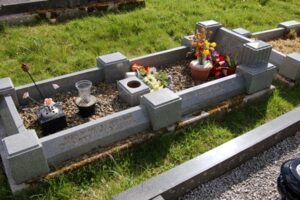
William Lincoln Morgan, Private, 14473327, Welch Regiment. William was born at Ammanford on 11 February 1928, the son of William Morgan and Elizabeth Morgan (nee Mainwaring), of Ammanford. He served with the 1st Battalion, Welch Regiment. In November 1951 the 1st Welch disembarked at Pusan, Korea. The Welch took over a section which had been held at great cost by the 1st Gloucesters, and spent a hard winter patrolling the frontier of South Korea, under constant shelling and mortar fire. William was wounded in Korea, and died on 15 February 1952, aged 24. He is buried at Yokohama British Commonwealth Cemetery, Japan.
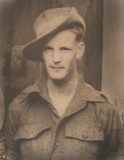
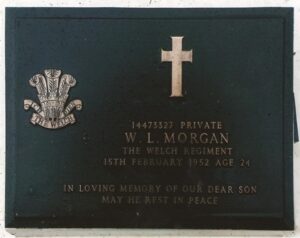
Cyprus Emergency
The Mediterranean island of Cyprus had been governed by Britain since 1878, and was an important military base, within reach of the volatile Middle East and Israel. The Cyprus Emergency was a military action that began after the launching of a Terrorist campaign by the Greek Cypriot group EOKA on 1 April 1955, and the British Governor of the Island declared a state of emergency on 26 November 1955. The emergency ultimately led to Cyprus being granted independence in 1960.
Bernard Peters, Corporal, 23386240, Welch Regiment. Bernard was born in Llanelli on 23 May 1938. He served with the Welch Regiment. He was he was killed during an ambush at Ardhana in the Troodos Mountains on 7 October 1958, aged 20. He was originally buried in Wayne’s Keep Cemetery, but his body was later repatriated and buried at Llanelli.
Malayan Emergency, 1950-1960
Following the end of WW2, the economy of Malaya had slumped, causing considerable unrest. On 18 June 1948 three estate managers were murdered by Malayan Communist guerrillas at Perak, thus beginning a state of emergency which would last for years. No operations were launched to counter the insurgency until 1950, and that year the British High Commissioner of Malaya was murdered. This brought British and Australian troops into war, but it took ten years to bring the threat under control. For more details on the Malayan Emergency, please read the excellent piece on the Wikepedia website.
Howard Thomas Albutt, Flight Lieutenant, 54978, Royal Air Force. Howard was born on 25 October 1920, the son of Edwin Albutt and Louise Albutt (nee Herbert), of Llanelli. He served with the Royal Air Force. He died on 20 February 1959 aged 38 and is buried in Cheras Road Christian Cemetery, Kuala Lumpar.
Vernon Bowen, Sergeant (Navigator), 1654380, Royal Air Force. Vernon was born at Cross Hands on 20 September 1923. Details of his service are not known, as the World War 2 service records are as yet unobtainable, but Vernon was serving at Singapore, based at RAF Tengah, as a Navigator with 45 Squadron, Royal Air Force during the Malayan Emergency. The Malayan Emergency was a guerrilla war for independence fought between Commonwealth armed forces and the Malayan National Liberation Army, the military arm of the Malayan Communist Party, from 1948 to 1960. The Royal Air Force flew Avro Lincolns and Bristol Brigands from Singapore on bombing raids over Communist Malaya. Vernon was Navigator of a three man crew of a Bristol Brigand, consisting of Pilot Alan Martin and Radio Operator Peter Weston. On the morning of 15 June 1951, the crew were asked to do an air test on their Brigand VS857 (OB-K), and took off from Tengah just before lunch. The aircraft was headed north and climbing when what seemed like a massive explosion rocked the aircraft, and sent it out of control over Changi Creek, where it crashed moments later. Alan Martin and Peter Weston had survived, but sadly Vernon had been killed in the crash, his body being found underneath the wreckage of the fuselage. A later investigation found that a propeller had broken loose- a common problem on Brigands, and it was that which had made the aircraft lose control. Vernon was 27 years old when he died that day, and his body was interred at Kranji Military Cemetery.
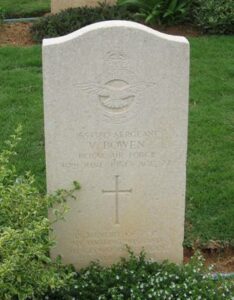
George Royston Evans, Fusilier, 22910228, Royal Welch Fusiliers. George was born at Garnant on 14 June 1935, the son of David William Evans, of 16, Cwmamman Road, Garnant. He served with the 2nd Battalion, Royal Welch Fusiliers. The battalion served during the Malayan Emergency, in support of the Malayan Government against the Communist uprising. George was killed in Malay on 19 January 1955. He was just 19 years old. The Armed Forces Roll shows him as being buried at Cheras Road Christian Cemetery, Kuala Lumpar, Malaysia, but another roll shows that he may have been cremated or his body repatriated.
Christopher Edward A. Hobbs, Private, 23219756, Royal Army Medical Corps. Christopher was born at Saundersfoot on 10 March 1936, the son of Ernest and Caroline Hobbs. He served with the Royal Army Medical Corps. Christopher died at Singapore on 4 November 1956, aged 20. He was originally buried at Kranji Military Cemetery, Singapore, but it seems that his body may have been repatriated home for burial.
Douglas A Charles Hurren, Private, 21016566, Army Catering Corps. Douglas was born on 14 July 1923, the son of Vaughan Price Hurren and Sarah Jane Hurren (née John), of Llanelli. He served with the Army Catering Corps, and was attached to the Cameronians. Douglas died on 15 July 1951, aged 29, and is buried in Kranji War Cemetery, Singapore. His brother Vaughan was killed during the Korean War.
Albert Eric Pike, Flight Lieutenant, 1315895, Royal Air Force. Albert was born on 23 January 1921, the son of Frank Pike and Janet Pike (nee Llewellyn), of Llanelli. He served with the Royal Air Force, based at RAF Seletar in Singapore. He died on 13 November 1958, aged 37 and is buried in Kranji Military Cemetery, Singapore.
Arthur John Rosser, Flying Officer, 607156, Royal Australian Air Force. Arthur was born at Swansea on the 16 September, 1929. He was educated at Llandovery College, and joined the Royal Air Force, where he was awarded his Pilots wings on 19 February, 1950. Arthur was posted to 77 Squadron, based at RAF Iwakuni, just 8 miles from Hiroshima in Japan. Arthur was attached to the Royal Australian Air Force, and had fought during the Korean War. He died on Saturday 28 March 1953. Arthur is buried at Terendak Military Cemetery, Malacca Malaysia, and is commemorated on the Commonwealth Memorial at the United Nations Memorial Cemetery, Pusan. He was 23 years old.
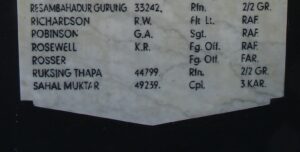
Aden Emergency, 1963-1967
Britain had governed Aden since 1839, to provide a base for merchant traders heading to India. It was made a Crown Colony in 1931, and the British began attempting to create a federation between Aden and the surrounding Arab protectorates in order to stabilise the region, declaring that Aden would remain a British Garrison. By 1963 this new Federation of South Arabia faced two threats, both from tribes in the Radfan area, and from Egyptian backed Yemen. A high state of tension gripped the protectorate from 1963, but a fierce outbreak of fighting in 1967 saw the British eventually withdraw from Aden.
John Bernard Barry, Private, 23980557, South Wales Borderers. John was born at Llandeilo on 24 June 1945, the son of John and Isabella Barry. He served with the South Wales Borderers. Little else is known of him as yet, but he died, possibly of wounds suffered at Aden, on 12 April 1967, aged 21, and is buried at Llandeilo Parish Churchyard.
Falklands War, 1982
After years of arguments over ownership of the Falkland Islands, Argentina’s ailing military junta, worried about its countries ailing fortunes, gambled that a military takeover of the hotly disputed Malvinas Islands would revive their fortunes, and that Britain would not be able to respond militarily. On 2 April 1982, Argentina invaded the Falkland Islands, a move that led to a brief, but bitter war. On 5 April 1982 a large British Task Force left Britain to regain control of the islands which it had controlled for over 150 years, in support of its 1,800 strong population of loyal British citizens. In the fighting that followed, 655 Argentine and 255 British servicemen lost their lives, as did three Falkland Islanders, but the islands were recaptured by the British, and remain under our control today.
Gareth Melvyn Griffiths, Guardsman, 23929722, Welsh Guards. Gareth was born at Llandeilo on 13 March 1951, the son of John and Hannah Griffiths, and was the husband of Janice Griffiths. He joined the Welsh Guards straight from school, and had served at Cyprus and Northern Ireland prior to the Argentinian invasion of the Falkland Islands on 2 April 1982. As a result, the British Government sent a powerful naval task force to the Islands, arriving a month later. On 8 June 1982, Gareth was with the Welsh Guards aboard their troopship, the RFA Sir Galahad, when she was hit by an Argentinian bomb and set ablaze. Gareth was one of 56 men killed during the blaze, with over 150 more badly wounded. He has no known grave, and is commemorated on the Armed Forces Memorial, at Alrewas, Staffordshire. He was 31 years old, and left his widow with two young children.
Michael Anthony Jones, Private, 24398540, Army Catering Corps (Attached Welsh Guards). Michael was born at Carmarthen on 17 September 1959, and served with the Army Catering Corps, attached to the Welsh Guards. He was aboard the troopship RFA Sir Galahad when she was attacked by A4-C Skyhawks of the Argentinian Air Force on 8 June 1982, and was hit by three bombs. The resulting explosions and fire killed 48 men, mostly of the Welsh Guards, but also men of other units, including Michael. He is commemorated on the Armed Forces Memorial at Alrewas, Staffordshire.
Roger Nutbeem, Major, Royal Army Medical Corps. Roger was born in April 1942, the son of Frederick and Emily Nutbeem, and grew up in the town of Redditch in Worcestershire. He attended grammar school in Alcester, before starting further studies at agricultural college. After several years working in the industry, Roger decided to change his career, and in 1962 joined the RAMC as a dispenser, number 483497. In 1967 he was recommended for officer training, eventually taking on duties as a platoon officer. Roger rose through the ranks, and eventually became second in command of 16 Field Ambulance RAMC. In 1982, when Argentinian troops invaded the Falkland Islands, the British became involved in a war. to dislodge them from the Falklands. Roger, now a Major, was part of the RAMC deployed in early June to Ajax Bay, a settlement on East Falkland. The bay was used by the Royal Navy as a centre for military hospital ships, and after Roger arrived, he joined the crew on board the RFA Sir Galahad, which was travelling to Fitzroy, another settlement on the island. He was aboard Sir Galahad when it was attacked by A4-C Skyhawks of the Argentinian Air Force on 8 June 1982, and was hit by three bombs. The resulting explosions and fire killed 48 men, mostly of the Welsh Guards, but also men of other units, including Roger. His body was recovered to shore where he was temporarily interred, and was then repatriated to the UK, where Roger was buried in the military cemetery at Tidworth, Wiltshire. In 1993 the British army opened a military hospital in the Midlands naming it in honour of Roger Nutbeem. He left a widow, Patricia, and two young children Martin and Kathryn, who is a well known musician.
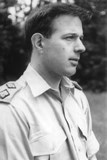
Eirwyn John Phillips, Guardsman, Welsh Guards. Eirwyn was born at Carmarthen on 4 June 1962, the son of William Gwynfor Phillips and Phoebe Violet Phillips (nee Lewis). He served with the 1st Battalion Welsh Guards. Eirwyn was aboard the Troopship RFA Sir Galahad when it was attacked by A4-C Skyhawks of the Argentinian Air Force on 8 June 1982, and was hit by three bombs. The resulting explosions and fire killed 48 men, mostly of the Welsh Guards, but also men of other units. Eirwyn was 20 years old, and is commemorated on the Armed Forces Memorial at Alrewas, Staffordshire.
Nicholas David Mark Thomas, Lance Corporal, 24436475, Welsh Guards. Nicholas was born on 11 May 1957. He served with the 1st Battalion Welsh Guards. Nicholas was aboard the Troopship RFA Sir Galahad when it was attacked by A4-C Skyhawks of the Argentinian Air Force on 8 June 1982, and was hit by three bombs. The resulting explosions and fire killed 48 men, mostly of the Welsh Guards, but also men of other units. Nicholas was 25 years old, and is commemorated on the Armed Forces Memorial at Alrewas, Staffordshire.
Iraq War, 2003-2011
As a recent conflict, the Iraq War, or Gulf War, is well known by most of us. It began after Iraqi forces, led by Saddam Hussein, attacked and captured the adjoining country of Kuwait on 2 August 1990. Kuwait had been part of Basra Province under Ottoman rule, under the British forced the Turks out of the country in WW1. The Iraqi’s thus took control of the massive oil reserves held by Kuwait, but sparked the First Gulf War, when UN initialised coalition forces re-took Kuwait, after a short but bloody campaign, code named Operation Desert Storm, which lasted from 17 January 1991 until 28 February 1991. Harsh cease-fire terms were brought down on Iraq, but these led to the outbreak of the Second Gulf War 12 years later, when coalition forces invaded Iraq under the thought that the Iraqis had amassed a cache of weapons of mass destruction.
Eddie Collins, Sergeant, Special Air Service. Eddie was born at Milford Haven on 12 November 1973, and had joined the 2nd Battalion, The Parachute Regiment, before being posted to their elite Pathfinder Platoon. He had passed the gruelling selection test for the Special Air Service before being posted to Iraq as part of a hard arrest team. On 5 September 2007 Eddie was the troop leader of a large hard arrest team that burst into a house in Baghdad to arrest a terrorist leader, but he was shot in the head and killed. He was 33 years old. As is usual with S.A.S. operations, no more details can be found. Eddie was brought home for burial at Credenhill Military Cemetery.
Ryan Francis, Lance Corporal, The Royal Welsh. Ryan was from Llanelli, and had joined the Royal Welsh in 2003, and was deployed to Iraq as a Warrior armoured car driver. He was killed while on patrol with his battle group in the early hours of 7 July 2007, when the warrior armoured vehicle he was travelling in was struck by a roadside bomb. He died instantly at a location in the Hay Al Mudhara district of Basra. Ryan was 23 years old, and was brought home for burial at Llanelli.
Mark Gibson, Flight Sergeant, Royal Air Force. Mark was born on 19 March 1970 in York, and was raised at Cardiff and Pembrokeshire after his father had been posted to RAF St Athan and then to RAF Brawdy. He followed in his father’s footsteps, joining the Royal Air Force, where he trained as an Air Loadmaster before being posted to 47 Squadron, Royal Air Force. Mark was among ten men killed when their C-130K Hercules crashed near Baghdad on 30 January 2005. His body was flown home along with his fellow airmen.
Afghanistan War, 2001 to 2014
After a series of terrorist attacks, culminating in the destruction of the World Trade Centre in New York on 11 September 2001, the Western Powers of the USA and Britain embarked on an invasion of Afghanistan, in order to destroy the Al Qaeda supporting Taliban, and in the process eradicate a major Al Qaeda training ground. On 7 October 2001, the British and Americans launched their assault on the country, to be joined later by other UN forces. As we know today, the campaign is not quite over, and our troops are still on active service in this hostile country, but a major player in world terrorism had been brought to its knees by this difficult campaign.
Dan Collins, Lance Corporal, Welsh Guards. Dan was from Tiers Cross. He had served in Helmand Province with the Welsh Guards, where he had lost two of his best friends, and had suffered several close shaves, being shot twice and being involved in two bomb blasts. He returned home but suffered badly from post-traumatic stress disorder, before committing suicide in a quarry at Rosebush on 1 January 2012, aged 29. Dan was buried at Cardigan (St. Mary’s) Church.
Lee Thomas Davies, Lance Corporal, Welsh Guards. Lee was born at Carmarthen on 15 October 1984, and had been raised at Cardigan. He served in Afghanistan with the 1st Battalion, Welsh Guards. Lee was one of two soldiers shot dead by Afghanistan Policemen on 12 May 2012. He was 27 years old, and was brought home to be buried at Cardigan (St. Mary’s) Church.
David Dennis, Lance Corporal, The Light Dragoons. David was born on 16 May 1980, the son of Roger and Adele Dennis of Llanelli. He joined the Army on 14 February 2003 as a gunner in the Royal Artillery before joining The King’s Troop. Having served with the Gunners for just over two years, he was attached to The Light Dragoons for a six-month tour of Iraq in 2005. On 4 July 2009, he was travelling in an armoured vehicle during Operation Panthers Claw, an operation involving around 3,000 soldiers, to improve security in the area north of Lashkar Gah, clear the Babaji and Malgir areas of insurgents and restore government control before the national elections, when the vehicle was hit by a rocket-propelled grenade, and he was killed. David was 29 years old, and was buried at All Saints Church, Llanelli. He left behind his mother Adele Dennis and his twin brother Gareth of Llanelli, his father Roger, step mother Helen and step brother Matthew of Port Talbot and his fiancée Lisa.
David Greenhalgh, Lance Sergeant, Grenadier Guards. David was from Ilkeston, Derbyshire, but had been brought up at Hermon, Pembrokeshire after his parents moved the family to West Wales in 2000. He served with the 1st Battalion, Grenadier Guards. David was killed while travelling in an armoured Jackal vehicle which was struck by an explosive device while on patrol in Lashkar Gah in Helmand Province on 13 February 2010. He was 25 years old, and was brought home for burial at Mansfield (St. Mark’s) Church.
Richard Hunt, Private, The Royal Welsh. Richard was from Haverfordwest. He moved to Abergavenny prior to joining the 2nd Battalion, Royal Welsh. Richard was badly wounded during an explosion of an IED in Afghanistan on 12 August, and died at the Royal Centre for Defence Medicine in Selly Oak on Saturday 15 August 2009. He was 21 years old, and was buried at St. Mary’s Church, Llanellen.
Jamie Kirkpatrick, Corporal, Royal Engineers. Jamie was born in Edinburgh, but lived in Llanelli, with his wife Heidi and their daughter Holly. He had enlisted into the Royal Engineers in 1997, and following his training was posted to Germany. Over the next six years he qualified as a Class 1 Plant Operator Mechanic, and deployed to Iraq on Operation TELIC. During 2009 he gained his Intermediate Explosive Ordnance Disposal qualification, and in April 2010 volunteered for a tour of Afghanistan and was attached back to 33 Engineer Regiment (Explosive Ordnance Disposal). Jamie was deployed to Kajaki in the Sangin District of Helmand Province to work with 40 Commando Royal Marines Battle Group and played a large part in increasing the freedom of movement for the local Afghans by removing Improvised Explosive Devices from key routes as well as conducting life-saving training to members of the Battle Group. The team then moved to support the 1st Battalion Royal Gurkha Rifles Battle Group, Combined Force Nahr-E Saraj (South), and Jamie was killed during a firefight there on 27 June 2010. He was 32 years old.
Nigel Dean Mead, Marine, Royal Marines. Nigel was born at Carmarthen, the son of Philip and Amanda Mead, and was educated at Queen Elizabeth School. He joined the Royal Marines in October 2008. He was sent to Afghanistan with 42 Commando, Royal Marines, on his first tour of duty. Nigel was searching a compound in Helmand province when he was killed by an improvised explosive device on 15 May 2011. He was just 19 years old.
Samuel Robinson, Bombardier, Royal Artillery. Samuel was born in Carmarthen, and joined the Army on 23 November 1999 when he was 20. He transferred from 13 Air Assault Support Regiment, Royal Logistic Corps in 2006 as a parachute trained corporal, and joined 4/73 (Sphinx) Special Observation Post Battery, 5th Regiment Royal Artillery. In March 2008, after successfully passing the Patrol Course he was selected as a Royal Artillery Special Observer. Samuel was deployed on his fourth operational tour in Afghanistan in May 2010, and was second in command of a Surveillance and Target Acquisition Patrol from 4/73 (Sphinx) Special Observation Post Battery Royal Artillery. On 8 July 2010, Samuel was on a local area patrol in Sangin, with members of A Company, 1st Battalion, The Mercian Regiment, when he was killed by an Improvised Explosive Device. He was 31 years old.
Nicholas Webster-Smith, Corporal, Royal Military Police. Nicholas was born at Carmarthen in May 1985, the son of Richard and Jacqueline Smith. He attended Llangunnor Primary School and Queen Elizabeth Cambria Secondary School in Carmarthen before moving to Tenby, West Wales where he completed his education at Greenhill School, Tenby. He later lived in Brackley, Northamptonshire. Following his basic, Nicholas enlisted into the Corps of Royal Military Police in February 2005 and after training was posted to 160 Provost Company, Aldershot in November 2005. During his time at 160 Provost Company, as well as conducting Garrison Policing he completed a tour of duty in Afghanistan, a deployment in Kosovo, and a Joint Service Policing tour of the Falkland Islands. On 3 November 2009, Nicholas was among a small party of five MP’s who were sat at a checkpoint in the Nad e Ali District in Helmand Province, when an Afghan policeman who had been training with them opened fire on them, killing Nicholas and the four other men. Nicholas was 24 years old.
Home Service/ Miscellaneous Wars
Men from West Wales have lost their lives in non-war operations as well. The majority of these servicemen that have been killed during inter-war periods have lost their lives while training, or from accidents while performing their duty. Some of these servicemen were based around the world, at Cyprus, The Mediterranean, Germany, and Northern Ireland to name but a few.
John Raymond Baldock, Pilot Officer, 4087075, Royal Air Force. John was born on 4 January 1932, the son of William and Phyllis Baldock, of Portsmouth, Hampshire. He served at RAF Pembrey with 233 OCU. He was killed when he crashed his Vampire jet, Serial VZ106, into Fan Hir, in the Black Mountains on 9 October 1953. John was just 21 years old, and is buried at Pembrey.
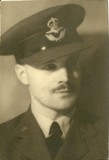
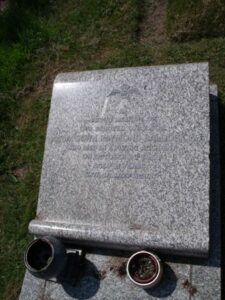
Raymond Hiley Harries, DSO, DFC, Squadron Leader, Royal Air Force. Raymond was born in Llandilofawr in 1916 and by 1939 was studying dentistry at Guy’s Hospital, London. He enlisted into the Royal Air Force and after training as a pilot was posted to 43 Squadron in Scotland. He was then posted to 52 OTU as an instructor before being posted to 131 Squadron at Llanbedr as a flight commander, claiming his first kill when he shot down a Junkers 88. On 19 August 1942 Ray took part in the aerial operation covering the ill-fated Dieppe raid, claiming one kill and sharing two others. He was awarded the DFC for his work during the day. He was then given command of 91 Squadron at Hawkinge which received the new Griffon engined Spitfire XII in April 1943. He became the highest scoring Griffon Spitfire ace, scoring 11 kills in this aircraft alone and was also credited with the downing of a V-1 flying bomb. He spent some time in the US lecturing on tactics before returning to Britain to become Wing Leader of 135 Wing, 2nd TAF, in the spring of 1944. By the end of the war Ray had been awarded the DSO and Bar, and the DFC and two bars and had scored 15 victories against enemy aircraft, as well as three shared kills, two probable kills and five damaged as well as the destruction of the V-1 flying bomb. He remained in the RAF and became CO of 92 Squadron. Ray was killed on 14 May 1950 when flying a 92 Squadron Gloster Meteor F4 which ran out of fuel and stalled. He attempted to bale out of the stricken aircraft but his parachute became entangled in its rear wing and he was killed. He was buried in Newton-on-Ouse (All Saints) Churchyard. He left behind his widow Doreen and at least one child. The photograph of Ray is courtesy of the IWM, while that of his grave is from Find A Grave.
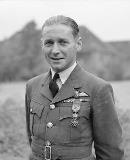
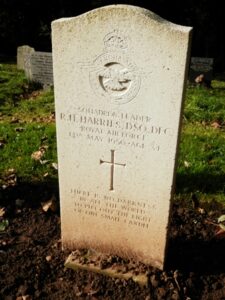
Frederick William Rupert Jacques, Pilot Officer, 3520735, Royal Air Force. Frederick was born 27 June 1929 at Batu Gajah, Malaya, the son of Frederick Viel Jacques and Evelyn Bessie Jacques (nee Salter). He served with 233 OCU based at RAF Pembrey. Frederick was killed on 20 June 1957 when his Hawker Hunter, Serial WT563, crashed soon after take-off into Kidwelly Railway Station. Frederick was 27 years old and is buried at Pembrey.
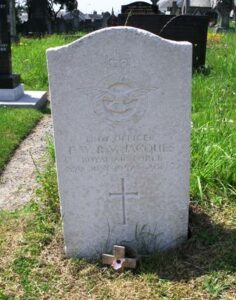
David H. Jones, Corporal, Royal Air Force Police. Nothing is yet known about David at present, but the Abergwili memorial states that he died in Carmarthenshire during May 1948 aged 28. This would have been too late for him to be recorded as an official casualty of the Second World War by the Commonwealth War Graves Commission.
Ivor Gwyn Jones, Bombardier, 21192503, Royal Artillery. Ivor was born at Llanelli on 8 May 1920. He served with the Royal Artillery, and died in a motorcycle accident at Pemberton Road on 2 October 1949, aged 29. He is buried at Old Road Cemetery, Llanelli with his brother who died in infancy in 1917. According to his family he served with the REME as a Mechanical Engineer, but the official records state he was serving with the Royal Artillery.
John Garner Jones, MC, Major, 92411, Welch Regiment. John was born in Llandovery in 1911 and was educated at Llandovery College. He was commissioned into the Welch Regiment before volunteering to serve with the Special Service Troops, which became known as No 1 Commando. He was awarded the Military Cross in recognition for gallant services during offensive patrols in Burma (London Gazette 22 March 1945). He survived the war and returned to Alma House, Llandovery where he died on 21 June 1947 aged thirty six. He is not commemorated as an official war casualty.
William Howell Morse, Lieutenant, Royal Navy. William was born at New Mill, Laugharne on 18 January 1931, the son of William Twin Morse and Sarah Ann Morse (nee Howells). He was educated at Whitland Grammar School, and after leaving in 1946, passed his entrance exam for the Royal Navy. He originally joined as an Artificers Apprentice and passed out four years later as a Petty Officer. The Royal Navy was looking to recruit pilots at the time, so William applied, and was accepted. After undertaking further officer training, William undertook flying training at RAF Lossiemouth in Scotland. He then successfully passed his jet conversion training before joining 800 Squadron, Fleet Air Arm at Brawdy in March 1955. After six months at Brawdy, during which time William flew over New Mill several times, the Squadron was posted to HMS Ark Royal for her maiden voyage to the Mediterranean. On 14 October 1955 Ark Royal passed through the Straits of Gibraltar. William was the first man to take off that day, but the catapult failed, and without the extra boost in speed to get airborne, Williams’ aircraft plunged off the deck into the sea. The ship was stopped and a search was carried out, but there was no trace of William nor his aircraft. William was 24 years old when he died that day, and is commemorated on the Armed Forces Memorial at Alrewas, Staffordshire. Many thanks to Walter Morse for sending in the information about his brother William.
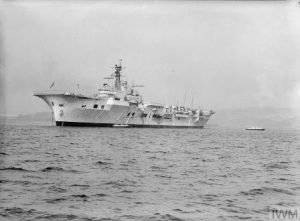
Christopher Proud, Warrant Officer, Royal Army Ordnance Corps. Christopher was 39 years old when he died while on service in Germany on 5 December 1965. He is buried at Fishguard Pentower Chapel Cemetery.
Denzil Ray, 24076081, Guardsman, Welsh Guards. Denzil was born on 13 July 1950, and lived at Burry Port. He served with the Welsh Guards. Denzil died in a House Fire at Burry Port on 1 January 1971, aged just 20. He was buried at St. Illtyd’s Churchyard, Pembrey.
Martin Peter Rees, Gunner, 24912155, Royal Artillery. Martin was born on 28 August 1974. He died on 13 March 1992, aged 17.
Patrick Francis Cranleigh Swash, 2600130, Flight Lieutenant, Royal Air Force. Patrick was born at Hendon, London on 18 June 1927. He was educated at Llandovery College, and at Clare College, and later joined the Royal Air Force, serving at RAF Wunstorf in Germany, which had been used for the Berlin Airlift. Patrick was killed in a flying accident while serving with the Royal Air Force in Germany on the 24 September 1952.
David Rudolph Bentley Thomas (Dolph), Corporal, 14493238, Royal Army Service Corps. ‘Dolph’, as he was known, was the nephew of John Thomas of Llanstephan. He was educated at Llandovery College, and served during the war with the Royal Army Service Corps. Dolph died on 15 March 1947, aged just 20, and is buried in Llanstephan Churchyard.
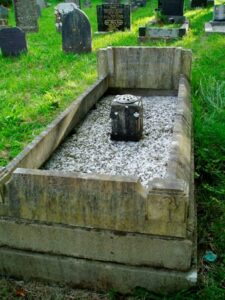
Leslie Aeron Thomas, 2542564, Aircraftman 2nd Class, Royal Air Force. Leslie was born at Carmarthen on 28 July 1933. He served with the Royal Air Force, and was based at RAF Deversoir. Leslie was killed on 23 July 1953, and is buried at Fayid Military Cemetery, Egypt. He was just 19 years old.
Lionel Hubert Wakeford, DFC, Squadron Leader, Royal Air Force. Lionel was born in Weymouth in 1915 and Joined the RAF at age 15 as an apprentice at RAF Halton. By the outbreak of WW2 he was a Sergeant Pilot in Egypt (Heliopolis) flying Bristol Bombay aircraft with 216 squadron, throughout North Africa and Greece. The squadron later returned to the U.K. flying Wellington Bombers. He was an early member of the Pathfinders with 139 Squadron flying Mosquito aircraft. By the end of the war he had flown over 2,400 hours at which time he had the rank of Squadron Leader. He was twice mentioned in Dispatches and received the Distinguished Flying Cross. Post war followed service with 29 Squadron. Moving to RAF Pembrey to form 233 Squadron a conversion unit in 1952 where he ran the tactical wing. On 22 September 1953, Lionel was training Pilot W.H. Williams in flying the Vampire Jet, and the aeroplane took off from Pembrey Airfield. However shortly after take-off Lionel requested permission to return to base. The aircraft was seen to weave for 2 miles approaching the airfield which was a method of losing speed. Unfortunately the Vampire crashed at the edge of the runway. The inquest found that the aircraft had suffered a sever fire probably starting immediately after take-off (possibly a re-ignite after a “flame out”) which had led to the crash. Both men were killed on impact, and Lionel is buried at Pembrey (St. Illtyd) Churchyard. On 9 March 1953, another Vampire Pilot based at Pembrey had been killed, when he crashed into a field at Llanybri.
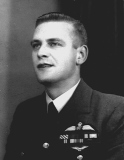
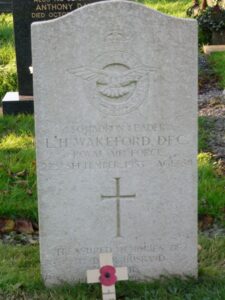
David Michael Whitby-James, Flying Officer, 3510259, Royal Air Force. David was born at Masterton, New Zealand on 10 May 1929. He was educated at Llandovery College before enlisting into the Royal Air Force, serving at RAF Deversoir, probably with 249 Squadron, flying the Vampire jet. David died on 17 November 1953, aged 24, and is buried at Wayne’s Keep Cemetery, Nicosia, Cyprus.
David Peter Williams, Leading Aircraftman, P8112099, Royal Air Force. David was born on 4 November 1957, the son of Aneurin and Muriel Williams, of Pontyates. He was a young entrant into the Royal Air Force, and was accidentally killed at RAF Coltishall on 16 September 1974, aged just 16. David is buried at Pontyates (St. Mary) Churchyard.
Eurfyl Williams, Private, 23040754, Royal Pioneer Corps. Eurfyl was born at Pontardulais on 6 March 1936, the son of Ernest and Alice Williams. He served with the Royal Pioneer Corps, and died near Shrewsbury on 13 July 1955, aged 19.
Paul Anthony Williams, Sergeant, 24545499, Adjutant General’s Corps. Paul was born in Fishguard on 3 January 1964. He served with the Adjutant General’s Corps and died on 8 October 2003, aged 38. He is buried in Fishguard Church Cemetery.
